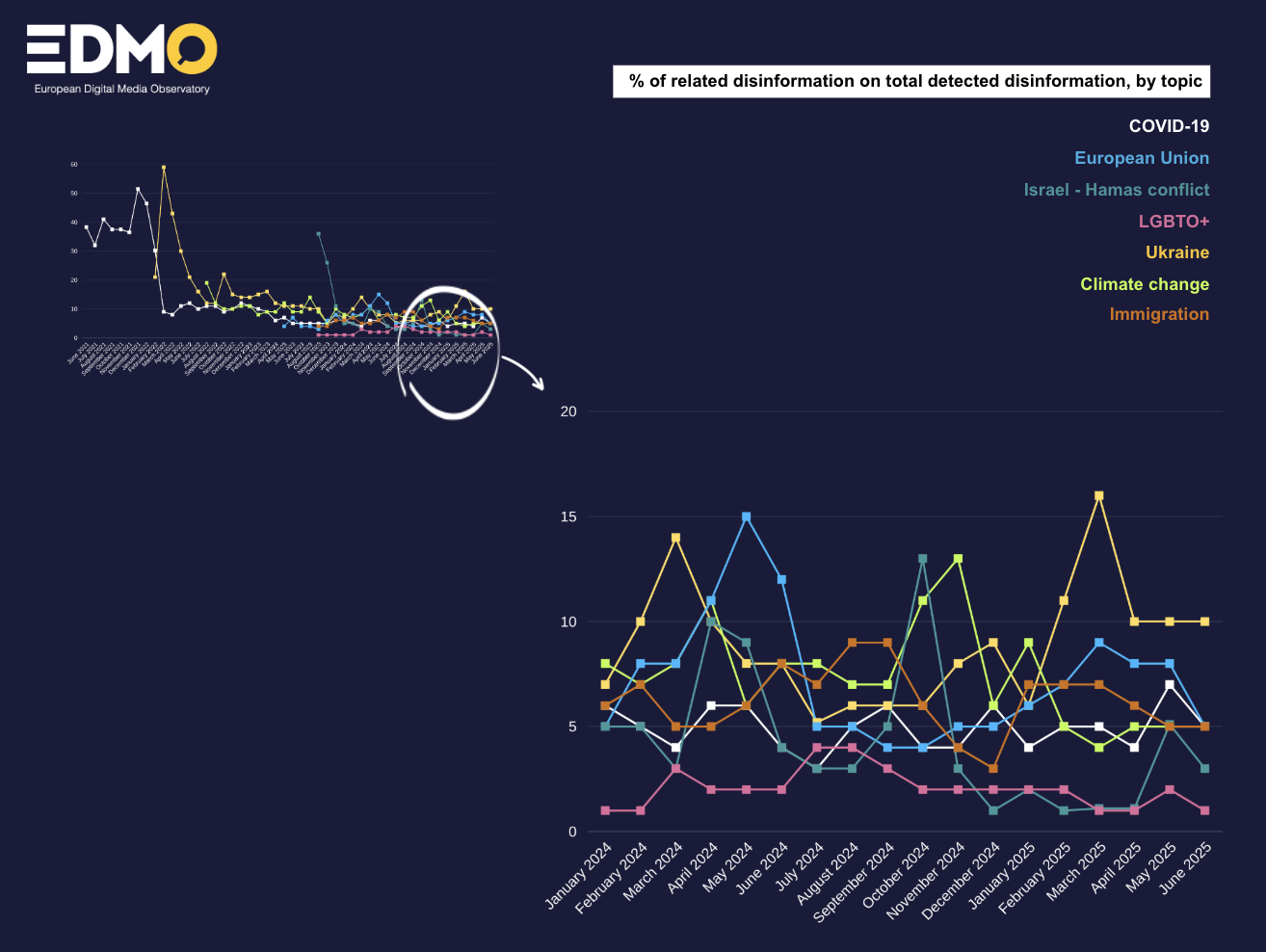THE WAR BETWEEN ISRAEL AND IRAN IS THE MOST TARGETED TOPIC
The 31 organizations* part of the EDMO fact-checking network that contributed to this brief published a total of 1.502 fact-checking articles in June 2025. Out of these articles, 212 (14%) related to the war between Israel and Iran**; 147 (10%) focused on Ukraine-related disinformation; 82 (5%) on disinformation related to immigration; 77 (5%) on disinformation related to the EU; 77 (5%) on COVID-19-related disinformation; 77 (5%) on climate change-related disinformation; 51 (3%) on the conflict involving Israel and Hamas in Gaza; and 14 (1%) on disinformation about LGBTQ+ and gender issues.
The most targeted topic by disinformation in the month of June has been the 12-day war between Israel and Iran, which also contributed to a major increase in AI-generated disinformation. In trend with the past months, the war in Ukraine also kept getting a lot of attention, with 10% of total false claims. Meanwhile, false stories related to the European Union and the Covid-19 decreased, as did disinformation on the conflict involving Israel and Hamas in Gaza, probably because of the attention shift towards the war with Iran.
The shares of false information about the other topics monitored by these briefs remained stable or showed only minor fluctuations.

CRISIS BETWEEN ISRAEL AND IRAN – NARRATIVES

Given the extensive media coverage of the 12-day war between Iran and Israel, disinformation narratives in the month of June largely focused on this topic. As reported by Iranian fact-checkers from IFCN signatory Factnameh, and highlighted by data gathered in Europe by EDMO, most false stories aimed at exaggerating the impact of Iran’s counter-attack towards Israel, fueling Iranian state propaganda. A claim that circulated widely in the EU was Iran’s alleged downing of Israeli F-35, which to this day remains unsubstantiated and denied by Israel. AI-generated videos showed the destruction of Ben Gurion airport in Tel Aviv; similarly, several pieces of content involved digitally created videos and images portraying destruction in the cities of Tel Aviv and Haifa, but also an old video claiming to show Iran’s alleged attack on the Mossad’s headquarters,
Other false claims instead focused on Israel’s attacks on Iran, with local Iranians allegedly celebrating the strikes, and a fabricated video of a blast in Evin prison in Tehran. Lastly, a widely circulated
false story (see slide n.7) involved Israeli PM Benjamin Nethanyahu, with the claim
that, after bombing Iran, he escaped to Greece.
CRISIS BETWEEN ISRAEL AND IRAN – TECHNIQUES
False content on this conflict registered an unprecedented use of artificial intelligence, contributing to the record of AI-genered content registered by EDMO, which increased to 10% (see slide n.7): in June, videos on this crisis and created with this technology were the most spread content among all EDMO fact-checking organizations (see slide n.8). It is still unclear why this happened, but it is likely due to the availability of technology that allows for the easy and inexpensive creation of realistic AI videos. In addition, the scarcity of real content, partially linked to Israel’s request not to disseminate pictures of the affected areas, may have contributed to the circulation of false images.
The use of AI represents a new tactic in conflict-related disinformation. Before it got popular, false stories on ongoing wars were mostly spread with the aid of videos and images taken out of their original context. Although AI is taking over, such content was also shared in the case of the attacks between Israel and Iran, and videos related to other conflicts or events circulated online. Another widely used tactic consisted of CGI (computer-generated imagery) extracted from war videogames, as it happened also recently for a video showing the alleged downing of an Israeli F-35.
CLICK HERE FOR MORE INFORMATIONS ABOUT THE NEW EDMO MONTHLY BRIEF



